by Contributed | Feb 18, 2021 | Technology
This article is contributed. See the original author and article here.
Overview
In 2021, each month we will be releasing a monthly blog covering the webinar of the month for the Low Code Application Development on Azure solution. Low-code app dev on Azure is a new solution to demonstrate the robust development capabilities of integrating low-code Microsoft Power Apps and the Azure products you may be familiar with.
This month’s webinar is ‘Develop Application Lifecycle Management (ALM) processes with GitHub Actions and Power Apps.’ In this blog I will highlight what LCAD on Azure is, the 3 most prevalent products in the webinar and use cases and provide supporting documentation for you to learn more about the webinar’s content.
What is Low-code application development (LCAD) on Azure?
Low Code Application Development on Azure was created to help developers build business applications faster with less code, leveraging the Power Platform, and more specifically Power Apps, yet helping them scale and extend their Power Apps with Azure services.
For example, a pro developer who works for a manufacturing company would need to build a line-of-business (LOB) application to help warehouse employees’ track incoming inventory. That application would take months to build, test, and deploy, however with Power Apps’ it can take hours to build, saving time and resources.
However, say the warehouse employees want the application to place procurement orders for additional inventory automatically when current inventory hits a determined low. In the past that would require another heavy lift by the development team to rework their previous application iteration. Due to the integration of Power Apps and Azure a professional developer can build an API in Visual Studio (VS) Code, publish it to their Azure portal, and export the API to Power Apps integrating it into their application as a custom connector. Afterwards, that same API is re-usable indefinitely in the Power Apps’ studio, for future use with other applications, saving the company and developers more time and resources.
This is just one scenario that highlights the capabilities of the LCAD on Azure solution. To learn more about the solution itself there is a link at the bottom of this blog in the supporting documentation section. This month’s webinar will focus on the capability to automate application lifecycle management, like the above scenario, with GitHub Actions to further expedite and streamline the development process for developers.
Webinar Content
The webinar explains ‘Fusion Development’ a process that leverages the citizen developer to build low-code applications themselves, further reducing strain on development teams, but professional developers meeting citizen developer’s half-way by extending these applications with custom code.
The webinar includes 2 demos, one on the integration of API management and Power Apps, how to create a CI/CD pipeline using GitHub Actions.
The integration of API management and Power Apps will cover the no cliff extensibility capabilities of Power Apps and Azure together, how to export APIs to Power Apps, and how to connect API management with Power Apps via Microsoft Teams for free.
We introduced Azure API Management connectors to quickly publish Azure API Management backed APIs to the Power Platform for easy discovery and consumption, dramatically reducing the time it takes to create apps connecting to Azure services.
This means that enterprises can now truly benefit from existing assets hosted on Azure, by making these available to Citizen developers with just a few clicks in the Azure portal, thereby eliminating the additional steps to go create custom connectors in the Power Apps or Power Automate maker experiences.
The GitHub Actions demo will cover developer’s ability to build automated software development lifecycle workflows. With GitHub Actions for Microsoft Power Platform, developers can create workflows in their repository to build, test, package, release, and deploy apps; perform automation; and manage bots and other components built on Microsoft Power Platform.
Conclusion
The webinar is currently available on-demand, and the webinar in February will cover the integration of SAP on Azure and Power Apps.
Support Documents
Power Apps x Azure websites
Power Platform x Azure API Management Integration
Power Platform x GitHub Actions Automated SDLC workflows

by Contributed | Feb 18, 2021 | Technology
This article is contributed. See the original author and article here.
TLDR; Azure Space Mystery is an interactive experience teaching you about Space, women scientist and how you can interact with LEARN to solve mysteries in the game. Blast off for the Azure Space Mystery
Location: 400 km above Earth, traveling at 27,600 km/h. The space crew is in a good mood. They are looking forward to today’s return to Earth. We have made groundbreaking discoveries that will change the way we understand the …

Suddenly, a voice emanates from your communication console. “Captain, we have received an SOS message from the International Space Station. Their solar array wing was knocked off by debris. They are quickly running out of power! They need our help to collect the four missing pieces and deliver them back to the ISS as soon as possible.”
When that SOS call comes from the International Space Station, you know that you’re the person for the job!
Push the buttons and start your adventure! Will you embark on either the Rosetta, SOHO, Magnet, or Cluster Missions?
Azure Advocates and Community Advocacy PMs are excited to offer our third mystery experience, the Azure Space Mystery! Following on the Azure Mystery Mansion and the Azure Maya Mystery, this adventure sends you on missions in space to collect the four missing pieces of the wing. Store each piece in your space ship’s Collection Bay and find your way to the ISS to save the day.
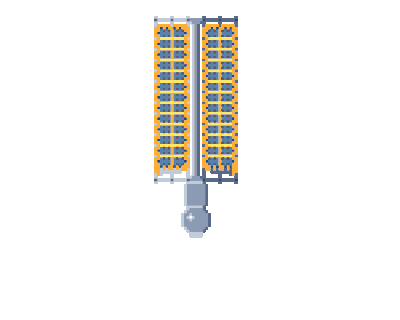
During your mission, you will have to solve code challenges and unlock elements of the ship to collect the items. Can you figure out the circumference of the spool around which you must wrap the missing wire? Can you find the keyword on Microsoft Learn to unlock the door so you can complete your space walk? What if you fly into the tail of a comet?
Curious how we built this game? It uses the same architecture as the Azure Maya Mystery: TailwindCSS, VuePress, and an Azure Static Web App.
Every great explorer finds helpers along the way, and the Space Mystery is no different. You will be helped at strategic moments by four famous women who, in history, helped advance scientific inquiry. You’ll have to play the game to discover who they are, but get ready to meet a mathematician, a pilot, a scientist, and an astronomer whose work spanned 14 centuries.
You’ll not only meet these inspiring scientific women in the game, but you can also meet them in Minecraft!

The connection between the Space Mystery game and Minecraft is made by your acquisition of a final badge, available when you complete your missions. Collect your Space Learner badger badge and use it in the MyMetaverse Minecraft server.
In the server, this badger token will give you exclusive access to a Heroes Hangout dedicated for Azure Heroes users. The server is accessible in Minecraft Java edition at mc.mymetaverse.io. To use the badge in the server, link an Enjin Wallet, which is the app where Azure Heroes tokens are stored.
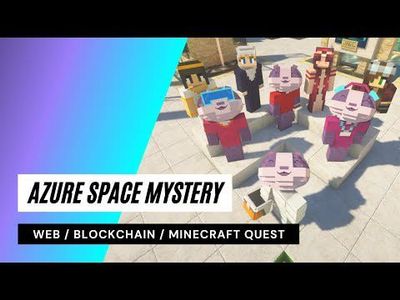
The Azure Space Mystery was brought to you in honor of the 6th International Day for Women and Girls in Science. This day was founded by the “Space Princess”: H.R.H. Princess Dr. Nisreen El-Hashemite. It is our hope that our game will teach a little about other famous and impactful women in Science.
But wait, there’s more! Download free wallpapers of our bespoke cosmic art for your video call backgrounds!

We would like to acknowledge the folks who contributed to the content of the game: Marc Duiker who did the pixel art, and Dr. Mark Looper, who provided space-focused technical expertise. Many thanks to the ‘mystery team’ of Cloud Advocates, Chris Noring and myself (Jen) and to our mysterious PM team, in particular Lucie Simeckova, Floor Drees, and Adam Jackson, Eva Amezua de Casado, Jan Schenk, Adi Stein Ben-Nun, and Cynthia Zanoni for overseeing production.
Are you ready to accept your mission to explore space? Let’s go! Blast off for the Azure Space Mystery
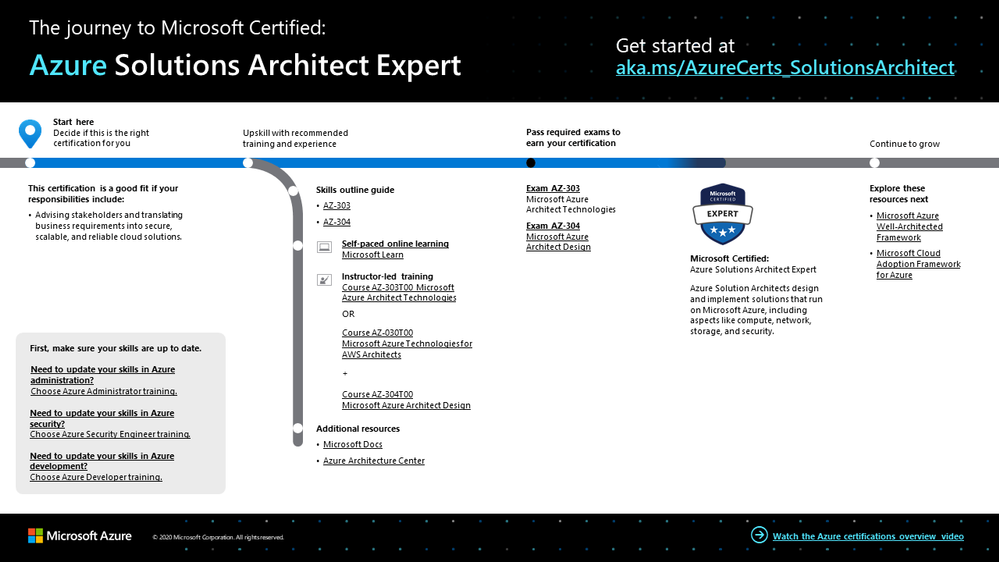
by Contributed | Feb 18, 2021 | Technology
This article is contributed. See the original author and article here.
How do organizations today balance risk, cost, and capabilities—while continuing to deliver business value? The cloud can address all of these issues, and it has transformed the way businesses solve their technology challenges. Microsoft Azure solutions architects are the key to implementing cloud architecture, using resources efficiently, and maintaining security—whether migrating an existing system to the cloud or building a new one.
The Azure Solutions Architect Expert certification validates that you have what it takes to design and implement solutions that run on Azure, including aspects like compute, network, storage, and security. You earn this certification by passing Exam AZ-303: Microsoft Azure Architect Technologies and Exam AZ-304: Microsoft Azure Architect Design.
If your responsibilities include advising stakeholders and translating business requirements into secure, scalable, and reliable cloud solutions—especially if you partner with cloud administrators, cloud database administrators, and clients to implement solutions—this could be the certification for you.
What kind of knowledge and experience should you have?
As a candidate for this expert-level certification, an Azure solutions architect has the skills to design end-to-end solutions for Azure, considering infrastructure, apps, data, security, and more. Since it’s the most comprehensive certification, it’s suitable for IT pros, developers, and data professionals. If your experience is on the infrastructure side, you might need to reinforce your apps and data design and architecture skills. If you’re coming from the developer side, be sure to reinforce your Azure administration skills. And all candidates need to be experts in DevOps processes.
When you’re skilled up and confident in your administration and developer foundations, combine them with your advanced experience and knowledge of IT operations. These include networking, virtualization, identity, security, business continuity, disaster recovery, data platform, budgeting, and governance. And you should know how to manage the way that decisions in each area affect an overall solution.
How can you get ready?
To help you plan your journey, check out our infographic, The journey to Microsoft Certified: Azure Solutions Architect Expert. You can also find it in the resources section on the certification and exam pages, which contains other valuable help for Azure solutions architects.
 The journey to Azure Solutions Architect Expert
The journey to Azure Solutions Architect Expert
To map out your journey, follow the sequence in the infographic. First, decide whether this is the right certification for you, and then make sure your administration and development skills are up to date. To understand what you’ll be measured on when taking Exam AZ-303 and Exam AZ-304, review the skills outline guides for Exam AZ-303 and Exam AZ-304 on the exam pages.
Sign up for training that fits your learning style and experience:
Then take a trial run with the Microsoft Official Practice Test for AZ-303: Microsoft Azure Architect Technologies and the Microsoft Official Practice Test for AZ-304: Microsoft Azure Architect Design. All objectives of the exams are covered in depth, so you’ll find what you need to be ready for any question.
Complement your training with additional resources, like Microsoft Docs or the Azure Architecture Center.
After you pass the exam and earn your certification, check out the many other certification opportunities. Want to add to your Azure knowledge? Explore the Microsoft Azure Well-Architected Framework.
Note: Remember that Microsoft Certifications assess how well you apply what you know to solve real business challenges. Our training resources are useful for reinforcing your knowledge, but you’ll always need experience in the role and with the platform.
Celebrate your Azure talents with the world
When you earn a certification or learn a new skill, it’s an accomplishment worth celebrating with your network. It often takes less than a minute to update your LinkedIn profile and share your achievements, highlight your skills, and help boost your career potential. Here’s how:
- If you’ve earned a certification already, follow the instructions in the congratulations email you received. Or find your badge on your Certification Dashboard, and follow the instructions there to share it. (You’ll be transferred to the Acclaim website.)
- To add specific skills, visit your LinkedIn profile and update the Skills and endorsements section. Tip: We recommend that you choose skills listed in the skills outline guide for your certification.
Keep your certification up to date
If you’ve already earned your Azure Solutions Architect Expert certification, but it’s expiring in the near future, we’ve got good news. You’ll soon be able to renew your current certifications by passing a free renewal assessment on Microsoft Learn—anytime within six months before your certification expires. For more details, please read our blog post, Stay current with in-demand skills through free certification renewals.
It’s time to level up!
Your Microsoft Certification can help validate that you have the skills to stay ahead with today’s technology. It can also help empower you with a boost in confidence and job satisfaction—and maybe even a salary increase. Want to know more? In our blog post, Need another reason to earn a Microsoft Certification?, we offer 10 good reasons to earn your certification.
In modern business, the cloud is definitely here to stay. Be future-ready! Validate your skills and experience as an Azure solutions architect expert by earning your certification. Then apply key principles and best practices to your cloud solutions to meet your organization’s needs. Prove your worth to your team and company by designing, building, and continuously improving secure, reliable, efficient, and scalable architecture on Azure—today and in the future.
Related announcements
Understanding Microsoft Azure certifications
Finding the right Microsoft Azure certification for you
Master the basics of Microsoft Azure—cloud, data, and AI
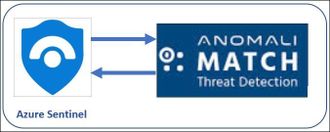
by Contributed | Feb 18, 2021 | Technology
This article is contributed. See the original author and article here.
Azure Sentinel is a cloud native SIEM that provides various ways to import Threat Intelligence data and use it in various parts of the product like hunting, investigation, analytics, workbook etc. It enables customers to harness the power of threat intelligence to find actionable threats.
Anomali Match is a high–performance security solution that detects threats within Sentinel observed data and identifies the point of origin of an attack, going back more than 5 years. With this intelligence, Match gives security teams the ability to investigate associated global threats, actors, techniques and potential future attacks and their impact on an organization’s security posture.
Today we want to highlight the availability of a new integration between Azure Sentinel and Anomali Match, which will allow you to:
- Bring in logs using a simple Kusto Query from Azure Sentinel into Anomali Match
- Correlate logs with millions of Threat Intelligence records imported within Anomali Match to create detection alerts
- Export the alerts created by these matches back into Azure Sentinel in form of Common Security (CEF) logs, and then create incidents on top of them for triage by the Security Operation Center analyst team in your organization.

Anomali Match + Microsoft Azure Sentinel Solution
The Anomali match and Azure Sentinel integration provides a bi-directional flow of data between them. With this integration Azure Sentinel users can export log data out of Sentinel into Anomali match. This can be done simply by registering an application in Azure Active Directory to access the log analytics workspace and then configuring the Azure Sentinel log source on the Universal Link through the Anomali Match Interface. Once the log data is imported into Anomali Match, it can be used for matching against the threat intelligence in Anomali Match and generating alerts. These alerts can then be pushed back to Azure Sentinel using a CEF over Syslog collector. This allows importing high fidelity alerts from Anomali Match into the Common Security table of Azure Sentinel from where customers can generate incidents using simple KQL based scheduled rules for making them available for triage in Azure Sentinel. The device vendor for all these alerts is set to Anomali match.
This blog will give a walkthrough of the process of importing event data from Azure Sentinel into Anomali Match and then exporting alerts generated in Anomali Match back to Azure Sentinel for triage.
Importing logs from Azure Sentinel into Anomali Match
Collecting logs from Azure Sentinel and importing into Anomali Match involves the follows 2 steps:
1. Register an application in Azure Active Directory to access the log analytics workspace.
2. Configure the Azure Sentinel log source on the Universal Link through the Anomali Match Interface.
Register an application in Azure Active Directory to access the Log Analytics Workspace
To import logs from Azure Sentinel to Anomali match, you need to register an application which will enable access to the log analytics workspace of Azure Sentinel. The following steps can be used for doing so:
1. Open the Azure Portal and navigate to the Azure Active Directory.
2. Navigate to the App Registration option under Manage menu.
3. Select New Registration.
4. Enter the following information:
a. Name: This is a user-friendly name of the application. For example, Anomali Match for Log Analytics.
b. Supported account types: This is to decide who can use the application and access it.
c. Redirect URL: This can be left blank.
5. Click Register
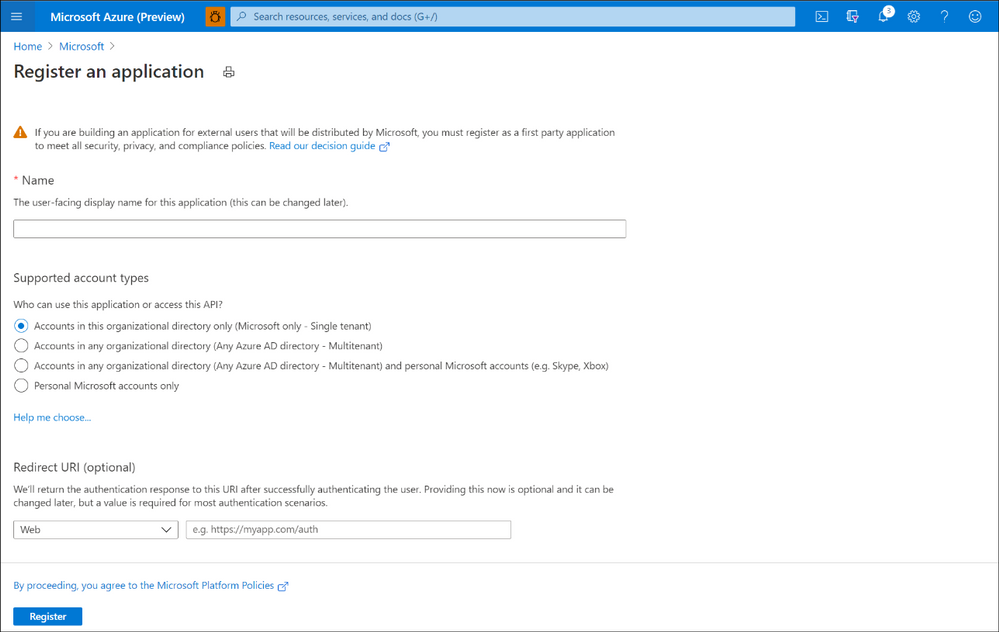
6. Once the app is registered, copy the Application (client) ID and Directory (tenant) ID. You will need these later to configure the Azure Sentinel log sources in Anomali Match.
7. Select Certificates & secrets from the Manage menu.
8. Click the New client secret option.
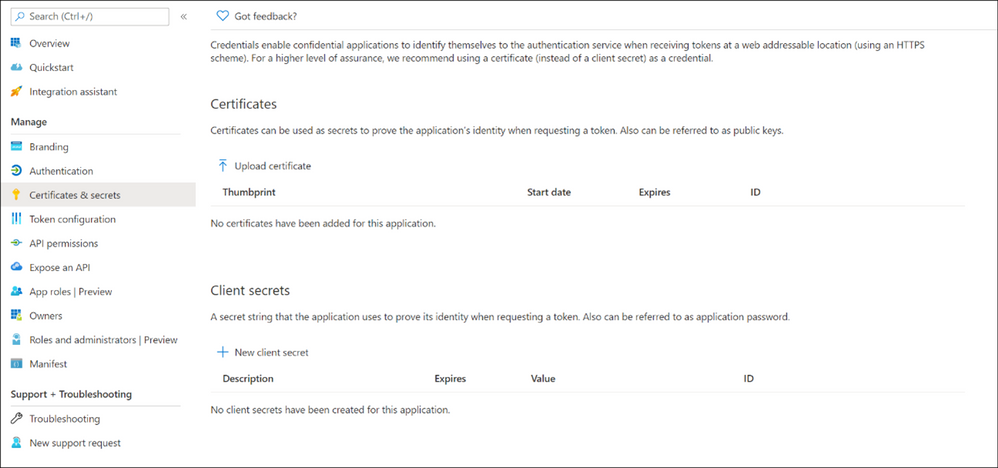
9. Enter a Description and select the Time-to-live for the new secret and click Add.

10. Copy the Value of the key. You will need this later to configure the Azure Sentinel log sources in Anomali Match.
11. Select the API permissions from the Manage menu.
12. Click Add a permission.
13. Navigate to the APIs my organization uses tab on the dialogue box that opens and search for Log analytics API.
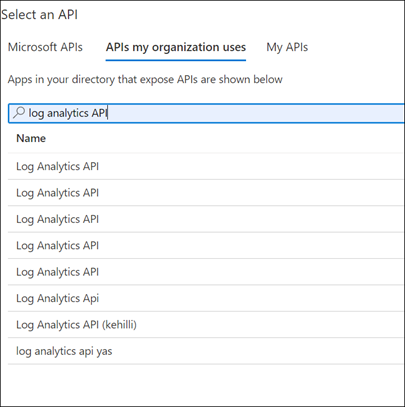
14. Select Delegated Permissions and enter the permissions below in the Select permissions text box. Permissions that need to be added are Data.Read. Select the permission and click Add.
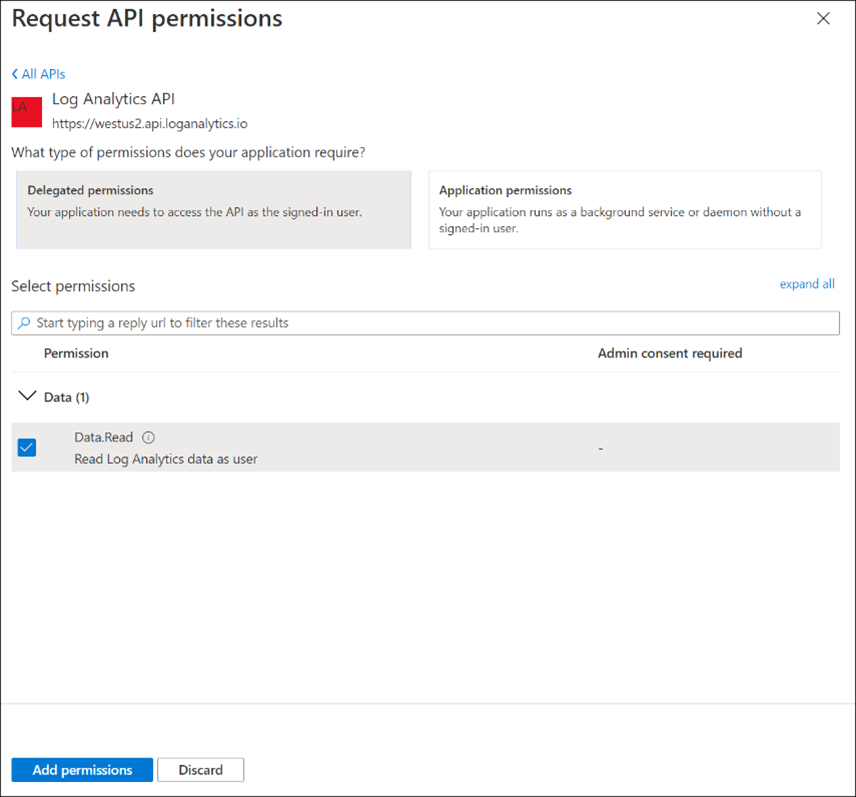
15. Navigate to the Log Analytics workspace that contains Sentinel Logs. To do so search Log Analytics Workspaces in the Azure Portal and select the workspace that contains Azure Sentinel Logs. Copy the Workspace ID from the Overview page. You would need this to configure Sentinel log sources in Anomali match.
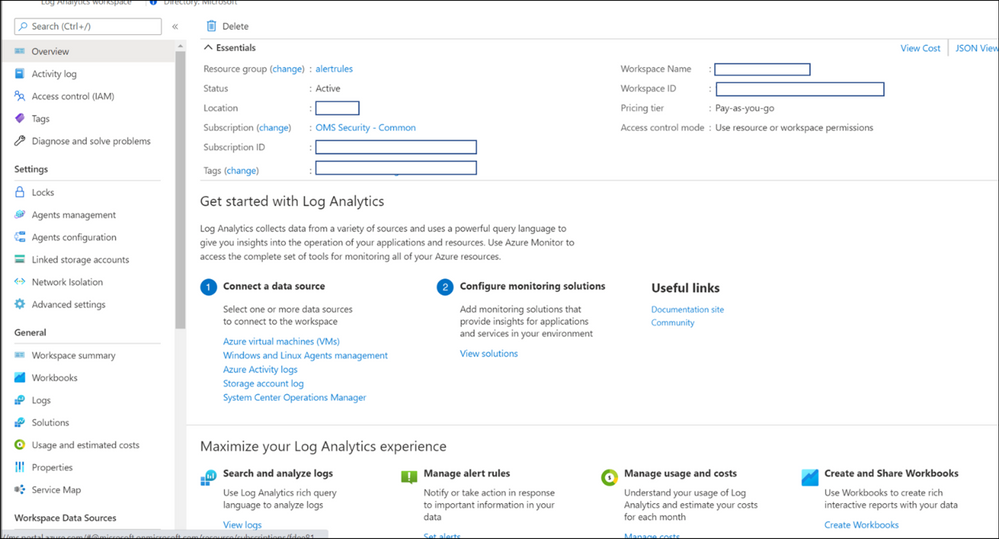
16. Navigate to the Access Control (IAM) menu. Click on Add -> Add role assignment. Select Log Analytics Reader from the role dropdown. Enter the name of your application in the Assign access to > Select text box. Once the name is visible in the list, select it. Click Save.
Configure the Azure Sentinel log source on the Universal Link through the Anomali Match Interface
Now that the application to access the Log analytics workspace is configured, we can use the Anomali Match Universal Link to add log sources in the Anomali Match user interface. To add logs sources, follow the below steps:
Add Azure Sentinel as a log source to Match
1. Click on the gear icon ( ) from the top right.
) from the top right.
2. Click Links from the left side. The list of configured links is displayed.
3. Identify and click the Universal Link to which you want to add the new log source. The link must be online.
4. Click the plus ( ) icon on the top right. The Add a Log Source popup displays the available log sources from the Link.
) icon on the top right. The Add a Log Source popup displays the available log sources from the Link.
5. Click on the Azure Sentinel icon.
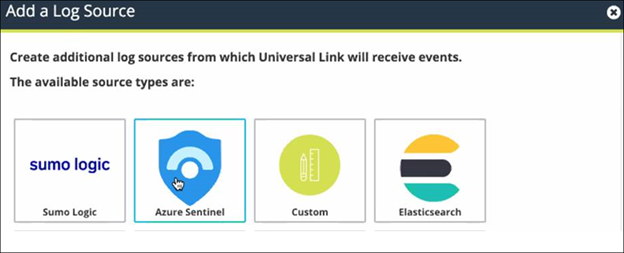
6. Enter a Data Source Name for the log source. Enter the Data Source Description which is a short description of the source and is an optional field.
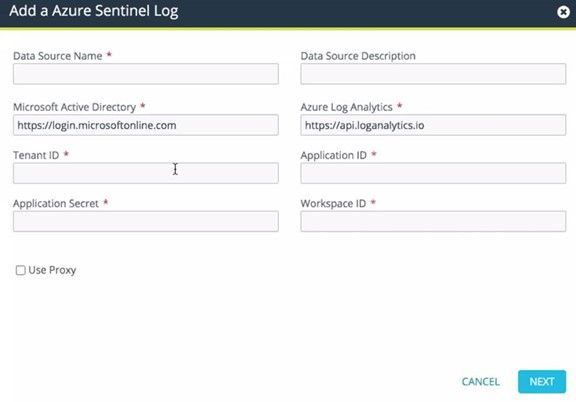
7. Configure settings related to your application as registered in Azure Active Directory (steps to which are given in the section Register an application in Azure Active Directory to access the Log Analytics Workspace above).
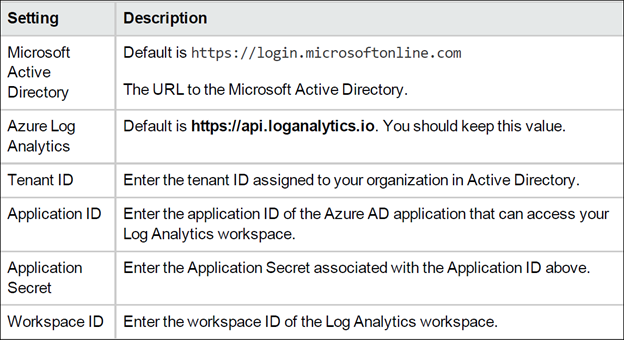
8. Click Use Proxy if you wish to use a proxy.
9. Click Next.
10. Enter the query string in the Search Query 1 field. This defines what data will be retrieved from the log source. The query syntax is:

A sample query is below:
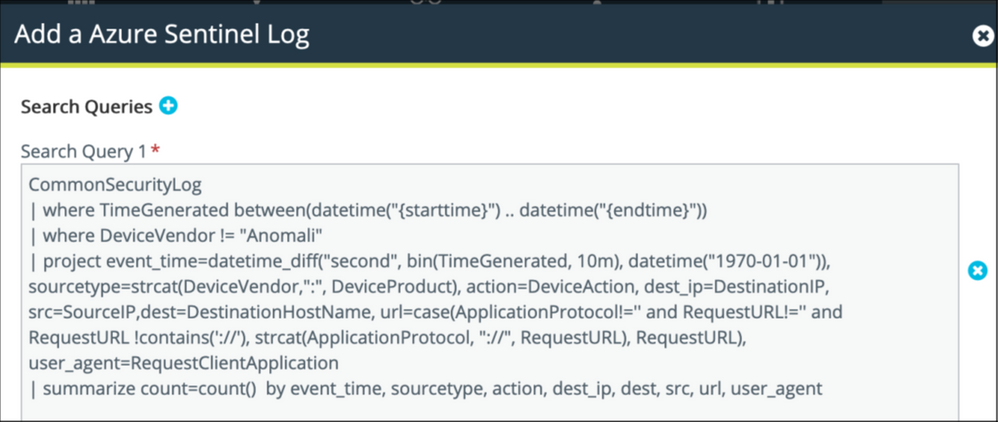
Click the plus sign ( ) to add another query for the same table. Then enter the additional query statement in the field on the same table in Sentinel.
) to add another query for the same table. Then enter the additional query statement in the field on the same table in Sentinel.
11. Enter the Interval Schedule. This is the time between each query run. Default value for this is 10 minutes.
12. Click Backfill Enabled if you want to specify how far back in time to go to the log
source to get data. This is an optional field.
Use one of the following formats to specify your backfill period:

13. Enter the Drilldown Settings as mentioned below:

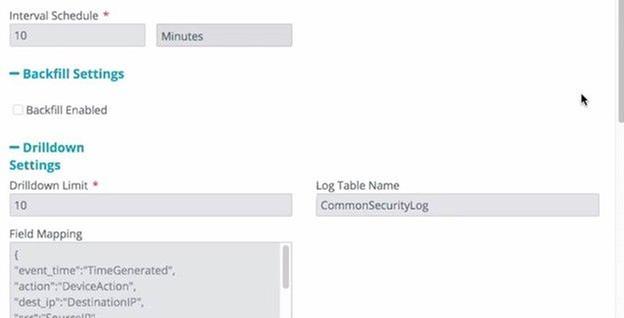
14. Click Save.
Now the configuration for pulling data from Azure Sentinel into Anomali match is complete. Once the data is imported in Anomali match it is matched against Threat Intelligence indicators in Anomali Match to generate alerts. You can view these alerts in the Anomali match portal :
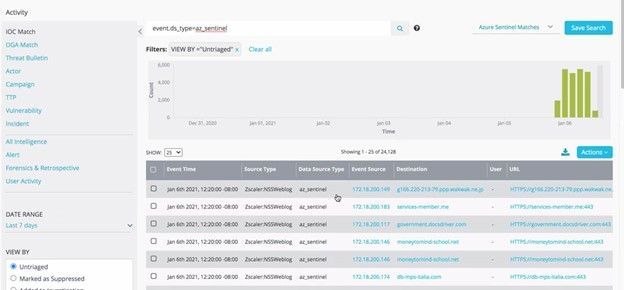
You can also drill down indicator details from the alerts to see additional context information about the indicator in the Anomali Match portal:
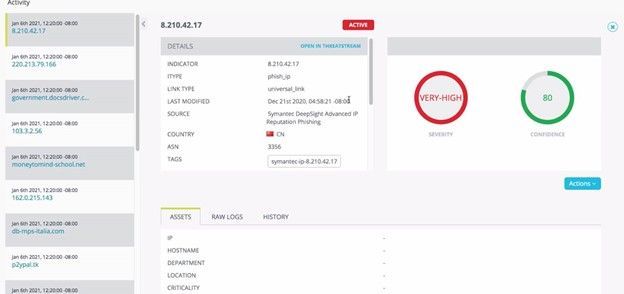
Exporting alerts from Anomali Match into Azure Sentinel
If you would like to import the Anomali Match alerts back into Azure Sentinel for further investigation and hunting, you can do so by setting up the CEF over Syslog connector. For doing so you will have to follow the below steps:
1. Create a Workflow for exporting alerts to Azure Sentinel in the Anomali Match portal. This can be done by clicking the Alerts option on the top bar.

2. In the Rule Workflow window, enter a Rule Name and Source. You can add Filters to decide which alerts you would like to export back to Azure Sentinel. In the Actions tab, you can configure forwarding using Syslog.
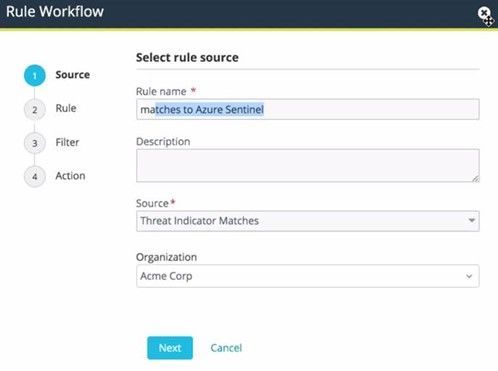
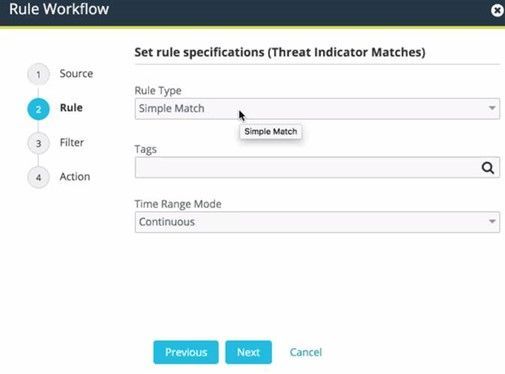
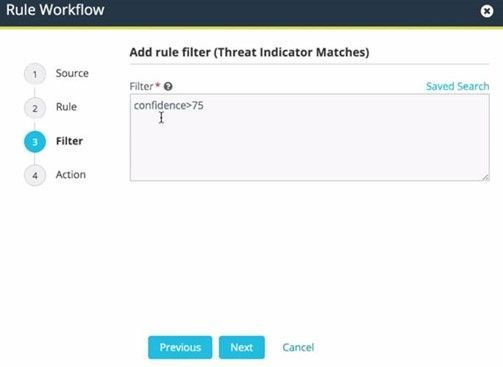
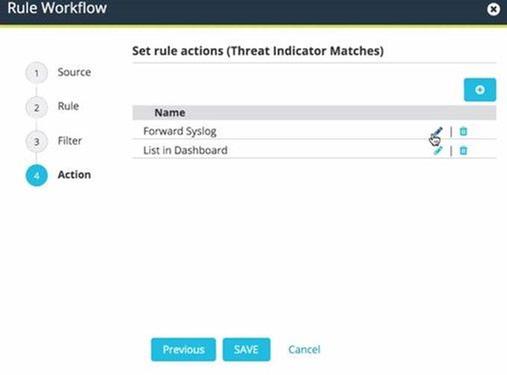
Once the alerts are imported into the Common Security table of Azure Sentinel, you can generate incidents using simple KQL based scheduled rules for making them available for triage in Azure Sentinel under the Incidents tab. This can be done by using the scheduled rule to look for the device vendor as the device vendor for all these alerts is set to Anomali. In order to do so, the following steps can be used:
1. Open the Azure Portal and navigate to the Azure Sentinel.
2. Navigate to the Analytics tab under the Configuration menu.
3. Click on the Create -> Scheduled query rule option.
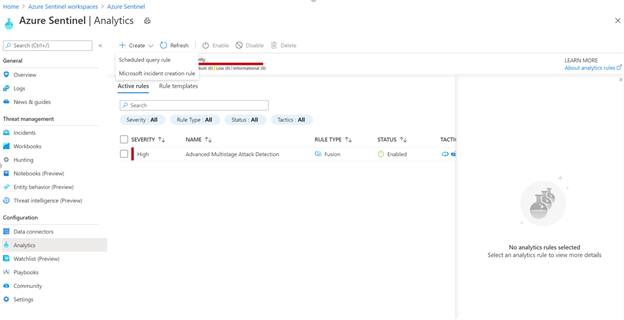
4. Add a Name for the analytics rule and make sure that the rule is Enabled. You can also add a Description for the rule and Tactics.
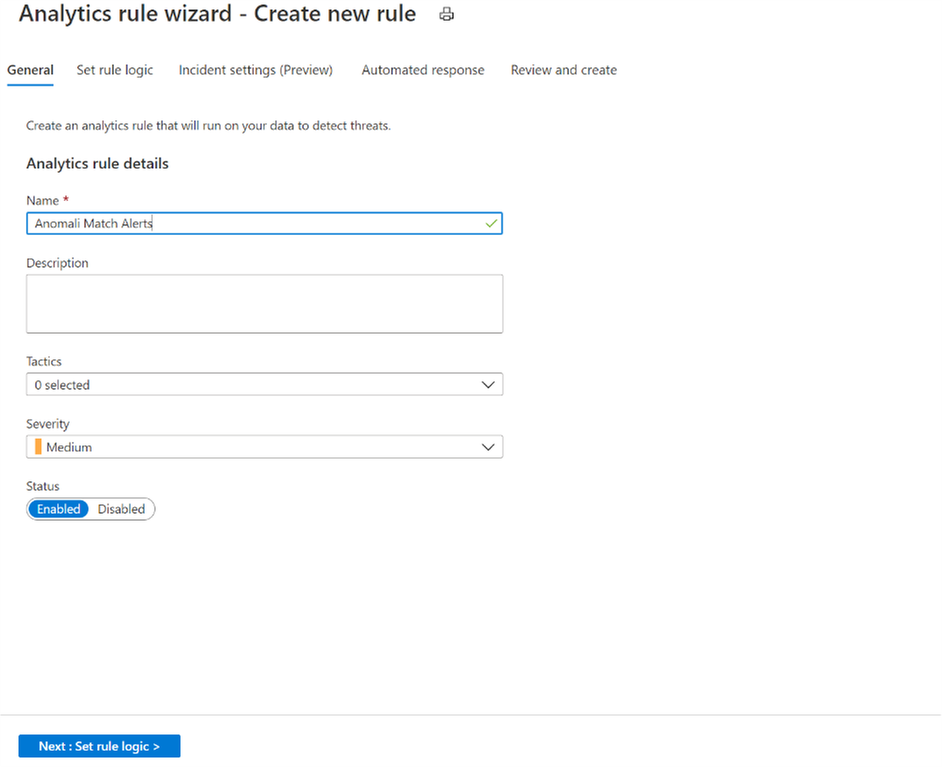
5. Click on the Next : Set Rule Logic button and add the KQL query. A sample query that you can use to generate incidents from the Anomali match alerts is as follows:
CommonSecurityLog
| where DeviceVendor == “Anomali”
6. Enable Alert grouping on the Incident settings page and playbooks (if any) on the Automated response page.
7. Create the rule on the Review and Create tab.
Summary
This unique integration between Azure Sentinel and Anomali match allows you to use the power of Threat Intelligence in Anomali for matching against log data from Azure Sentinel to find actionable threats. The bi-directional capabilities allow you to bring all the security insights gained from Anomali Match into Azure Sentinel for triage and analysis by your security operations team.
by Contributed | Feb 18, 2021 | Technology
This article is contributed. See the original author and article here.
Windows 10 introduced Windows as a service, a method of continually providing new features and capabilities through regular feature updates. Semi-Annual Channel versions of Windows, such as version 1909, version 2004, and version 20H2, are released twice per year.
In addition to Semi-Annual Channel releases of Windows 10 Enterprise, we also developed a Long Term Servicing Channel for Windows, known as Windows 10 Enterprise LTSC, and an Internet of Things (IoT) version known as Windows 10 IoT Enterprise LTSC. Each of these products was designed to have a 10-year support lifecycle, as outlined in our lifecycle documentation.
What are we announcing today?
Today we are announcing that the next version of Windows 10 Enterprise LTSC and Windows 10 IoT Enterprise LTSC will be released in the second half (H2) of calendar year 2021. Windows 10 Client LTSC will change to a 5-year lifecycle, aligning with the changes to the next perpetual version of Office. This change addresses the needs of the same regulated and restricted scenarios and devices. Note that Windows 10 IoT Enterprise LTSC is maintaining the 10-year support lifecycle; this change is only being announced for Office LTSC and Windows 10 Enterprise LTSC. You can read more about the Windows 10 IoT Enterprise LTSC announcement on the Windows IoT blog.
Frequently asked questions (FAQ)
Why are you making this change to Windows 10 Enterprise LTSC?
Windows 10 Enterprise LTSC is meant for specialty devices and scenarios that simply cannot accept changes or connect to the cloud, but still require a desktop experience: regulated devices that cannot accept feature updates for years at a time, process control devices on the manufacturing floor that never touch the internet, and specialty systems that must stay locked in time and require a long-term support channel.
Through in-depth conversations with customers, we have found that many who previously installed an LTSC version for information worker desktops have found that they do not require the full 10-year lifecycle. With the fast and increasing pace of technological change, it is a challenge to get the up-to-date experience customers expect when using a decade-old product. Where scenarios do require 10 years of support, we have found in our conversations that these needs are often better solved with Windows 10 IoT Enterprise LTSC.
This change also aligns the Windows 10 Enterprise LTSC lifecycle with the recently announced Office LTSC lifecycle for a more consistent customer experience and better planning.
You state that you are making this change to Windows 10 Enterprise LTSC to align with the changes to Office LTSC. Has your guidance changed on installing Office on Windows 10 Enterprise LTSC?
Our guidance has not changed: Windows 10 Enterprise LTSC is designed for specialty devices, and not information workers. However, if you find that you have a need for Windows 10 Enterprise LTSC, and you also need Office on that device, the right solution is Windows 10 Enterprise LTSC + Office LTSC. For consistency for those customers, we are aligning the lifecycle of the two products.
What about the current versions of LTSC – Windows 10 Enterprise LTSC 2015/2016/2019?
We are not changing the lifecycle of the LTSC versions that have been previously released. This change only impacts the next version of Windows 10 Enterprise LTSC, scheduled to be released in the second half of the 2021 calendar year.
What should I do if I need to install or upgrade to the next version, but I need the 10-year lifecycle for my device?
We recommend that you reassess your decision to use Windows 10 Enterprise LTSC and change to Semi-Annual Channel releases of Windows where it is more appropriate. For your fixed function devices, such as kiosk and point-of-sale devices, that need to continue using LTSC and are planning to install or upgrade to the next version, consider moving to Windows 10 IoT Enterprise LTSC. Again, we understand the needs for IoT/fixed purpose scenarios are different and there is no change to the 10-year support lifecycle for Windows 10 IoT Enterprise LTSC. For information on how to obtain Windows 10 IoT Enterprise LTSC, please reach out to your local IoT distributor.
Is there a difference in the Windows 10 operating system between Windows 10 Enterprise LTSC and Windows 10 IoT Enterprise LTSC?
The two operating systems are binary equivalents but are licensed differently. For information on licensing Windows 10 IoT Enterprise LTSC, please reach out to your local IoT distributor.
Where can I find more information about Windows 10 IoT Enterprise LTSC?
You can learn about the different Windows for IoT editions, and for which scenarios each edition is optimized in the Windows for IoT documentation. You’ll also find tutorials, quick start guides, and other helpful information. Check it out today!
When will Windows 10 IoT Enterprise LTSC announce their release?
Windows 10 IoT Enterprise LTSC will be released in the second half of 2021. You can read more about the Windows 10 IoT Enterprise LTSC announcement on the Windows IoT blog.
Continue the conversation. Find best practices. Visit the Windows Tech Community.
Stay informed. For the latest updates on new releases, tools, and resources, stay tuned to this blog and follow us @MSWindowsITPro on Twitter.






Recent Comments